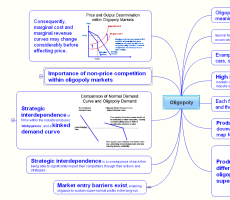Interactive mind maps in economics
![]()
These materials, authored by Maurice Starkey, are available under a Creative Commons Attribution-ShareAlike licence.
First published online by The Economics Network, April 2012.
Version 1.9 published November 2019.
New tutorial video and lecture videos added June 2020.
 Electronic mind maps improve learning efficiency by refining content to concisely express the main terms, enabling students to acquire knowledge more quickly. Learning effectiveness is increased by visual presentation of relationships between topics, and providing diagrams and rich pictures within topic boxes to reinforce meaning. Electronic delivery enables a wider range of topics to be covered than a traditional textbook, whilst simultaneously enabling theories to be considered in greater depth. The approach is intended to provide a blended learning solution that is used in conjunction with textbooks and journal articles. The intention is to create a body of freely available electronic subject material that can be further developed by the academic community.
Electronic mind maps improve learning efficiency by refining content to concisely express the main terms, enabling students to acquire knowledge more quickly. Learning effectiveness is increased by visual presentation of relationships between topics, and providing diagrams and rich pictures within topic boxes to reinforce meaning. Electronic delivery enables a wider range of topics to be covered than a traditional textbook, whilst simultaneously enabling theories to be considered in greater depth. The approach is intended to provide a blended learning solution that is used in conjunction with textbooks and journal articles. The intention is to create a body of freely available electronic subject material that can be further developed by the academic community.
A few mind maps have been exported to HTML format (Economic Environment, Oligopoly, Banks and Money Creation). These previews only show the basic functionality, with a slightly different layout, and the links to related mind maps will not work.
Introductory video
Downloading and viewing
The contents of the zip file can only be viewed by acquiring MindJet MindManager software: the viewer is a free download. Select "Download Trial" once you are on the web page.
Ensure that you only download the version of MindManager software that is compatible with your operating system, because there are separate packages for Microsoft Windows and Apple operating systems. There are also Mindjet MindManager versions for iPhone, iPad, and Android operating systems. Availability of software for Apple iPad and Android operating systems enable students to view the content on their tablet computer whilst in a lecture. Software should always be installed when the computer user is in administrator mode. Mindjet MindManager software is fully functional for the first 30 days, but will revert to only allowing viewing of content (rather than allowing creation of content) after this time. You do not need to purchase the software in order to simply view the content.
ZIP file of mind maps, version 1.9, November 2019
New to version 1.9:
- Mind map explaining the Quantity Theory of Credit.
- Development of content considering sources of market failure, Keynesian school, and transaction cost economics.
- New Microsoft Excel workbook containing both charts and data contained within the electronic economic mind maps.
To unzip the file: Navigate to the folder containing the zip file. Right click the zip file, and then select the option 'extract to' - then choose your preferred destination location for the unzipped folder. Once the downloaded zip file is unzipped, you will be able to view the content within MindJet MindManager.
Navigation
The above zip file contains all the electronic economic mind maps, which are interlinked. If you choose to download this zip file, you should begin by opening the master mind map entitled Economic Environment. This contains hyperlinks to all the sibling mind maps within the folder.
- A plus sign in a circle at the side of a topic box indicates the topic can be expanded to reveal sub-topics - Click the plus sign to reveal sub-topics.
- Click the minus sign in a circle at the side of a topic box to collapse sub-topics.
- Clicking on a red M at the side of a topic box opens a sibling mind map.
- A blue page with an orange pen at the side of a topic box indicates a note - hover your pointer over the note to read the content - alternatively, click the note to have a window open at the side of the screen that contains the content of the note.
- A green downward arrow in the top right hand corner of a topic box indicates that you can access a spreadsheet, or chart, by clicking the downward arrow.
- You can switch between spreadsheet and chart mode by clicking on the options box at the side of the topic box.
- Click a green upward arrow in the top right hand corner of the topic box to close the embedded spreadsheet / chart.
- The Search tab at the side of the screen in MindManager enables you to search the strategy maps folder for electronic mind maps that contain your desired search term.
Related video lectures
- Monetary Policy pt.1
The first part of lecture 10 on monetary policy considers the economic risks arising from the 2008 financial crisis, and explains Irving Fisher's debt deflation theory. During the lecture, I introduce students to the electronic economic mind maps that I have created.
(Powerpoint for this lecture) - Monetary Policy pt.2
The second part of this video lecture relates to expansionary monetary policy. Keynes liquidity preference theory and monetary transmission mechanisms are explained, in order to help students understand the approaches taken by central banks following the 2008 financial crisis.
(Powerpoint for this lecture)
See also

